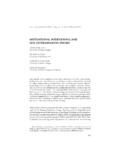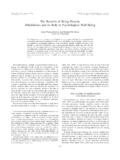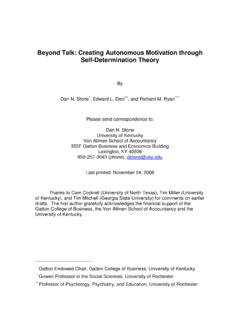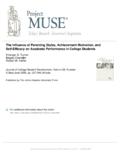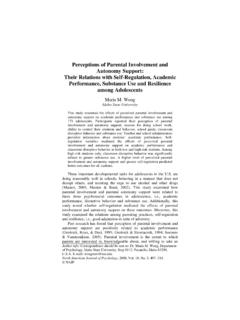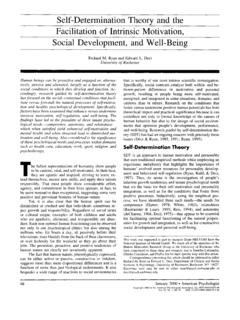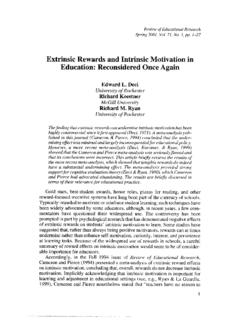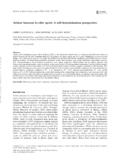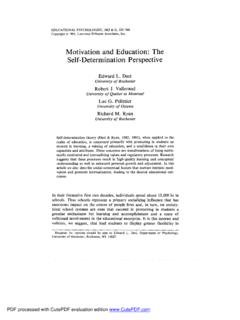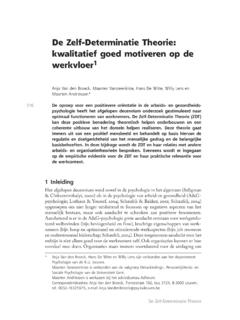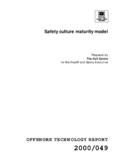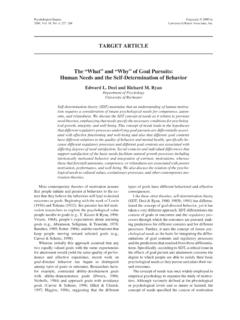Transcription of Intrinsic and Extrinsic Motivations: Classic Definitions ...
1 Contemporary Educational Psychology25,54 67 (2000) , available online at onIntrinsic and Extrinsic Motivations: Classic Definitions andNew DirectionsRichard M. Ryan and Edward L. DeciUniversity of RochesterIntrinsic and Extrinsic types of motivation have been widely studied, and thedistinction between them has shed important light on both developmental and educa-tional practices. In this review we revisit the Classic Definitions of Intrinsic andextrinsic motivation in light of contemporary research and theory. Intrinsic motiva-tion remains an important construct, reflecting the natural human propensity to learnand assimilate.
2 However, Extrinsic motivation is argued to vary considerably in itsrelative autonomy and thus can either reflect external control or true relations of both classes of motives to basic human needs for autonomy, compe-tence and relatedness are discussed. 2000 Academic PressTo be motivated meansto be movedto do something. A person who feelsno impetus or inspiration to act is thus characterized as unmotivated, whereassomeone who is energized or activated toward an end is considered moti-vated. Most everyone who works or plays with others is, accordingly, con-cerned with motivation , facing the question of how much motivation thoseothers, or oneself, has for a task, and practitioners of all types face the peren-nial task of fostering more versus less motivation in those around them.
3 Mosttheories of motivation reflect these concerns by viewing motivation as a uni-tary phenomenon, one that varies from very little motivation to act to a greatdeal of , even brief reflection suggests that motivation is hardly a unitary phe-nomenon. People have not only different amounts, but also different kindsof motivation . That is, they vary not only inlevelof motivation ( , howmuch motivation ), but also in theorientationof that motivation ( , whattype of motivation ). Orientation of motivation concerns the underlying atti-tudes and goals that give rise to action that is, it concerns the why of ac-tions.
4 As an example, a student can be highly motivated to do homeworkout of curiosity and interest or, alternatively, because he or she wants toprocure the approval of a teacher or parent. A student could be motivatedAddress correspondence and reprint requests to Richard Ryan, University of Rochester,Meliora 492, Rochester, NY $ 2000 by Academic PressAll rights of reproduction in any form AND Extrinsic MOTIVATIONS55to learn a new set of skills because he or she understands their potentialutility or value or because learning the skills will yield a good grade andthe privileges a good grade affords.
5 In these examples the amount of motiva-tion does not necessarily vary, but the nature and focus of the motivationbeing evidenced certainly Self-Determination Theory (SDT; Deci & Ryan, 1985) we distinguishbetween different types of motivation based on the different reasons or goalsthat give rise to an action. The most basic distinction is betweenintrinsicmotivation, which refers to doing something because it is inherently interest-ing or enjoyable, andextrinsic motivation , which refers to doing somethingbecause it leads to a separable outcome. Over three decades of research hasshown that the quality of experience and performance can be very differentwhen one is behaving for Intrinsic versus Extrinsic reasons.
6 One purpose ofthis review is to revisit this Classic distinction between Intrinsic and extrinsicmotivation and to summarize the functional differences of these two generaltypes of motivation has emerged as an important phenomena for educa-tors a natural wellspring of learning and achievement that can be systemati-cally catalyzed or undermined by parent and teacher practices (Ryan &Stiller, 1991). Because Intrinsic motivation results in high-quality learningand creativity, it is especially important to detail the factors and forces thatengender versus undermine , equally important in the current review is the explication ofthe very different types of motivation that fall into the category of extrinsicmotivation.
7 In the Classic literature, Extrinsic motivation has typically beencharacterized as a pale and impoverished (even if powerful) form of motiva-tion that contrasts with Intrinsic motivation ( , deCharms, 1968). How-ever, SDT proposes that there are varied types of Extrinsic motivation , someof which do, indeed, represent impoverished forms of motivation and someof which represent active, agentic can perform extrinsically motivated actions with resentment, re-sistance, and disinterest or, alternatively, with an attitude of willingness thatreflects an inner acceptance of the value or utility of a task.
8 In the formercase the Classic case of Extrinsic motivation one feels externally pro-pelled into action; in the later case, the Extrinsic goal is self-endorsed andthus adopted with a sense of volition. Understanding these different typesof Extrinsic motivation , and what fosters each of them, is an important issuefor educators who cannot always rely on Intrinsic motivation to foster learn-ing. Frankly speaking, because many of the tasks that educators want theirstudents to perform are not inherently interesting or enjoyable, knowing howto promote more active and volitional (versus passive and controlling)
9 Formsof Extrinsic motivation becomes an essential strategy for successful AND DECIWe detail in this article not only the different types of motivational orienta-tion that exist within the global Extrinsic category, but moreover, their differ-ential antecedents and sum, our aim in this article is to revisit the Classic distinction betweenintrinsic and Extrinsic motivation and detail the conditions that fosters , we describe a model of differing types of Extrinsic motivation . Ourconcern here is with how teachers, parents and other socializers can leadstudents to internalize the responsibility and sense of value for Extrinsic goalsor, alternatively, how they can foster the more typically depicted alienated type of Extrinsic motivation that is associated with low student persistence,interest, and MOTIVATIONI ntrinsic motivation is defined as the doing of an activity for its inherentsatisfactions rather than for some separable consequence.
10 When intrinsicallymotivated a person is moved to act for the fun or challenge entailed ratherthan because of external prods, pressures, or rewards. The phenomenon ofintrinsic motivation was first acknowledged within experimental studies ofanimal behavior, where it was discovered that many organisms engage inexploratory, playful, and curiosity-driven behaviors even in the absence ofreinforcement or reward (White, 1959). These spontaneous behaviors, al-though clearly bestowing adaptive benefits on the organism, appear not to bedone for any such instrumental reason, but rather for the positive experiencesassociated with exercising and extending ones humans, Intrinsic motivation is not the only form of motivation , or evenof volitional activity, but it is a pervasive and important one.
